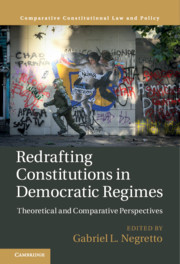Book contents
- Redrafting Constitutions in Democratic Regimes
- Comparative Constitutional Law and Policy
- Redrafting Constitutions in Democratic Regimes
- Copyright page
- Dedication
- Contents
- Tables
- Contributors
- Acknowledgments
- 1 New Constitutions in Democratic Regimes
- Part I Conceptual, Normative, and Empirical Issues
- 2 Constitution Making through Law
- 3 Expanding Revision Clauses in Democratic Constitutions
- 4 Courts and Constitution Making in Democratic Regimes
- 5 Replacing Constitutions in Democratic Regimes
- Part II Case Studies
- Index
- References
4 - Courts and Constitution Making in Democratic Regimes
A Contextual Approach
from Part I - Conceptual, Normative, and Empirical Issues
Published online by Cambridge University Press: 29 August 2020
- Redrafting Constitutions in Democratic Regimes
- Comparative Constitutional Law and Policy
- Redrafting Constitutions in Democratic Regimes
- Copyright page
- Dedication
- Contents
- Tables
- Contributors
- Acknowledgments
- 1 New Constitutions in Democratic Regimes
- Part I Conceptual, Normative, and Empirical Issues
- 2 Constitution Making through Law
- 3 Expanding Revision Clauses in Democratic Constitutions
- 4 Courts and Constitution Making in Democratic Regimes
- 5 Replacing Constitutions in Democratic Regimes
- Part II Case Studies
- Index
- References
Summary
Recent constitution-making episodes in countries such as Venezuela, Bolivia, Hungary, and Iceland have highlighted the important, varied roles that courts might play during constitution-making processes undertaken from a democratic starting point. This chapter develops a typology of the functions that courts have played during these processes. In some cases, courts have played a catalytic function, spurring constitution making that otherwise might not have occurred; in others, they have played a blocking function, stopping constitution making from taking place; and in a third set of cases, they have played a shaping function, neither catalyzing nor preventing constitution making, but instead impacting the nature of the process. These functions, in turn, tend to be tied to different theories of constitution making. What emerges from this survey is that there is no single best mode of judicial intervention during constitution making; the optimal response is contextual. A key descriptive goal is to understand how political context affects the ways in which courts act; a key normative goal is to improve the fit between the nature of judicial action and the needs of a given context.
Keywords
- Type
- Chapter
- Information
- Redrafting Constitutions in Democratic RegimesTheoretical and Comparative Perspectives, pp. 78 - 100Publisher: Cambridge University PressPrint publication year: 2020
References
- 3
- Cited by

